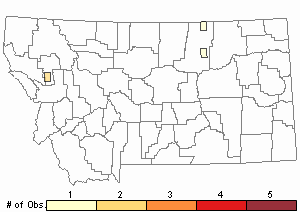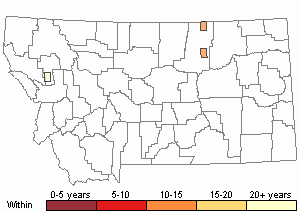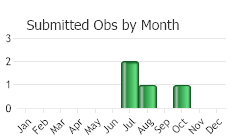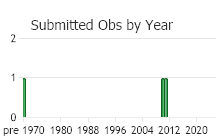View in other NatureServe Network Field Guides
NatureServe
Montana
Utah
Wyoming
Idaho
Wisconsin
British Columbia
South Carolina
Yukon
California
New York
Flowering Quillwort - Lilaea scilloides
Other Names:
Triglochin scilloides
State Rank Reason (see State Rank above)
Known in Montana from a couple recent collections and previously from a 1933 collection by C. L. Hitchcock about 2 miles southeast of Charlo and a 1965 collection about 1.5 miles southwest of Ninepipe Reservoir. Population sizes and trends for the species are unknown. However, addiditonal populations are likely to exist as many suitable, though un-surveyed ponds and wetlands exist across the state.
General Description
Flowering Quillwort is a tufted annual with leafless stems that are 3-20 cm high. The linear basal leaves are 2-25 cm long, are round in cross-section, and have a broad base that sheaths each flower stem. Male, female, or bisexual flowers are borne in an open spike that is 5-40 mm long and at the tops of stems, which are shorter than the leaves. Additional female flowers may be found partly enclosed by the leaf sheaths. Male and bisexual flowers consist of a green elliptic bract that is 2-3 mm long and of a single stamen and/or a single ovary. Female flowers consist of a solitary ovary. The narrowly lance-shaped fruits of the spike are 3-5 mm long, flattened, and wing-margined. Fruits borne in the leaf sheaths are cylindrical, 3-angled, and have 3 small horns at the tip.
Phenology
Mature fruit in July.
Diagnostic Characteristics
The flower spikes of Triglochin are longer than the leaves. The round leaves of Lilaea scilloides could also be mistaken for Eleocharis, Scirpus or Juncus but these other genera have stamens in sets of 2, 3, or 6 rather than solitary. Flowering Quillwort could be mistaken for a wetland grass, but the flowers are very different.
Species Range
Montana Range
Range Descriptions

 Native
Native
Range Comments
Western North America south to South America; introduced in Australia.
Observations in Montana Natural Heritage Program Database
Number of Observations: 4
(Click on the following maps and charts to see full sized version)
Map Help and Descriptions
Relative Density

Recency



 (Observations spanning multiple months or years are excluded from time charts)
(Observations spanning multiple months or years are excluded from time charts)
Habitat
Emergent or submerged in shallow water or mud around ponds in the valleys.
National Vegetation Classification System Groups Associated with this Species
Wetland and Riparian
Alkaline - Saline Wetlands
Wet Meadow and Marsh
Open Water
Open Water
Stewardship Responsibility
Threats or Limiting Factors
STATE THREAT SCORE REASON
Threat impact not assigned because threats are not known (MTNHP Threat Assessment 2021).
References
- Literature Cited AboveLegend:
 View Online Publication
View Online Publication MTNHP Threat Assessment. 2021. State Threat Score Assignment and Assessment of Reported Threats from 2006 to 2021 for State-listed Vascular Plants. Botany Program, Montana Natural Heritage Program, Helena, Montana.
MTNHP Threat Assessment. 2021. State Threat Score Assignment and Assessment of Reported Threats from 2006 to 2021 for State-listed Vascular Plants. Botany Program, Montana Natural Heritage Program, Helena, Montana.
- Additional ReferencesLegend:
 View Online Publication
View Online Publication
Do you know of a citation we're missing? Lesica, P., M.T. Lavin, and P.F. Stickney. 2012. Manual of Montana Vascular Plants. Fort Worth, TX: BRIT Press. viii + 771 p.
Lesica, P., M.T. Lavin, and P.F. Stickney. 2012. Manual of Montana Vascular Plants. Fort Worth, TX: BRIT Press. viii + 771 p. Lesica, P., M.T. Lavin, and P.F. Stickney. 2022. Manual of Montana Vascular Plants, Second Edition. Fort Worth, TX: BRIT Press. viii + 779 p.
Lesica, P., M.T. Lavin, and P.F. Stickney. 2022. Manual of Montana Vascular Plants, Second Edition. Fort Worth, TX: BRIT Press. viii + 779 p.
- Web Search Engines for Articles on "Flowering Quillwort"





